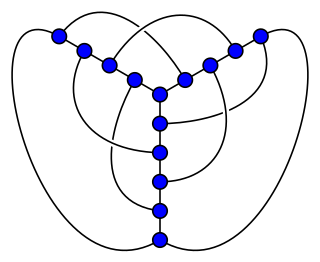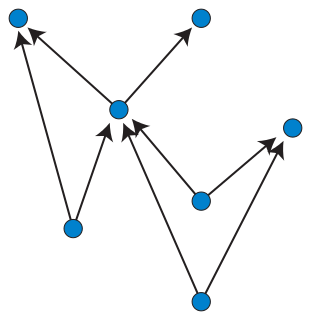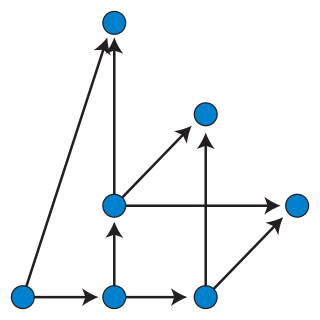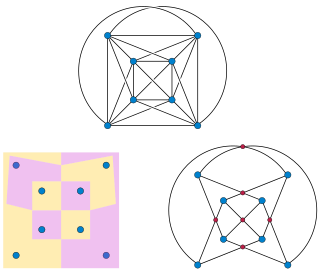Related Research Articles
In graph theory, a planar graph is a graph that can be embedded in the plane, i.e., it can be drawn on the plane in such a way that its edges intersect only at their endpoints. In other words, it can be drawn in such a way that no edges cross each other. Such a drawing is called a plane graph or planar embedding of the graph. A plane graph can be defined as a planar graph with a mapping from every node to a point on a plane, and from every edge to a plane curve on that plane, such that the extreme points of each curve are the points mapped from its end nodes, and all curves are disjoint except on their extreme points.

Graph drawing is an area of mathematics and computer science combining methods from geometric graph theory and information visualization to derive two-dimensional depictions of graphs arising from applications such as social network analysis, cartography, linguistics, and bioinformatics.

In graph theory, an outerplanar graph is a graph that has a planar drawing for which all vertices belong to the outer face of the drawing.

In graph theory, a book embedding is a generalization of planar embedding of a graph to embeddings into a book, a collection of half-planes all having the same line as their boundary. Usually, the vertices of the graph are required to lie on this boundary line, called the spine, and the edges are required to stay within a single half-plane. The book thickness of a graph is the smallest possible number of half-planes for any book embedding of the graph. Book thickness is also called pagenumber, stacknumber or fixed outerthickness. Book embeddings have also been used to define several other graph invariants including the pagewidth and book crossing number.
Planarity is a puzzle computer game by John Tantalo, based on a concept by Mary Radcliffe at Western Michigan University. The name comes from the concept of planar graphs in graph theory; these are graphs that can be embedded in the Euclidean plane so that no edges intersect. By Fáry's theorem, if a graph is planar, it can be drawn without crossings so that all of its edges are straight line segments. In the planarity game, the player is presented with a circular layout of a planar graph, with all the vertices placed on a single circle and with many crossings. The goal for the player is to eliminate all of the crossings and construct a straight-line embedding of the graph by moving the vertices one by one into better positions.
In polyhedral combinatorics, a branch of mathematics, Steinitz's theorem is a characterization of the undirected graphs formed by the edges and vertices of three-dimensional convex polyhedra: they are exactly the 3-vertex-connected planar graphs. That is, every convex polyhedron forms a 3-connected planar graph, and every 3-connected planar graph can be represented as the graph of a convex polyhedron. For this reason, the 3-connected planar graphs are also known as polyhedral graphs.

In geometric graph theory, a branch of mathematics, a matchstick graph is a graph that can be drawn in the plane in such a way that its edges are line segments with length one that do not cross each other. That is, it is a graph that has an embedding which is simultaneously a unit distance graph and a plane graph. For this reason, matchstick graphs have also been called planar unit-distance graphs. Informally, matchstick graphs can be made by placing noncrossing matchsticks on a flat surface, hence the name.

In graph drawing, the angular resolution of a drawing of a graph is the sharpest angle formed by any two edges that meet at a common vertex of the drawing.

In topological graph theory, a 1-planar graph is a graph that can be drawn in the Euclidean plane in such a way that each edge has at most one crossing point, where it crosses a single additional edge. If a 1-planar graph, one of the most natural generalizations of planar graphs, is drawn that way, the drawing is called a 1-plane graph or 1-planar embedding of the graph.
In graph drawing, a universal point set of order n is a set S of points in the Euclidean plane with the property that every n-vertex planar graph has a straight-line drawing in which the vertices are all placed at points of S.

In graph drawing, a circular layout is a style of drawing that places the vertices of a graph on a circle, often evenly spaced so that they form the vertices of a regular polygon.

An arc diagram is a style of graph drawing, in which the vertices of a graph are placed along a line in the Euclidean plane, with edges being drawn as semicircles in one or both of the two halfplanes bounded by the line, or as smooth curves formed by sequences of semicircles. In some cases, line segments of the line itself are also allowed as edges, as long as they connect only vertices that are consecutive along the line. Variations of this drawing style in which the semicircles are replaced by convex curves of some other type are also commonly called arc diagrams.
In graph drawing and geometric graph theory, a Tutte embedding or barycentric embedding of a simple 3-vertex-connected planar graph is a crossing-free straight-line embedding with the properties that the outer face is a convex polygon and that each interior vertex is at the average of its neighbors' positions. If the outer polygon is fixed, this condition on the interior vertices determines their position uniquely as the solution to a system of linear equations. Solving the equations geometrically produces a planar embedding. Tutte's spring theorem, proven by W. T. Tutte (1963), states that this unique solution is always crossing-free, and more strongly that every face of the resulting planar embedding is convex. It is called the spring theorem because such an embedding can be found as the equilibrium position for a system of springs representing the edges of the graph.

In graph drawing, an upward planar drawing of a directed acyclic graph is an embedding of the graph into the Euclidean plane, in which the edges are represented as non-crossing monotonic upwards curves. That is, the curve representing each edge should have the property that every horizontal line intersects it in at most one point, and no two edges may intersect except at a shared endpoint. In this sense, it is the ideal case for layered graph drawing, a style of graph drawing in which edges are monotonic curves that may cross, but in which crossings are to be minimized.

Dominance drawing is a style of graph drawing of directed acyclic graphs that makes the reachability relations between vertices visually apparent. In dominance drawing, vertices are placed at distinct points of the Euclidean plane and a vertex v is reachable from another vertex u if and only if both Cartesian coordinates of v are greater than or equal to the coordinates of u. The edges of a dominance drawing may be drawn either as straight line segments, or, in some cases, as polygonal chains.
In graph theory, the thickness of a graph G is the minimum number of planar graphs into which the edges of G can be partitioned. That is, if there exists a collection of k planar graphs, all having the same set of vertices, such that the union of these planar graphs is G, then the thickness of G is at most k. In other words, the thickness of a graph is the minimum number of planar subgraphs whose union equals to graph G.
In graph drawing, planarization is a method of extending drawing methods from planar graphs to graphs that are not planar, by embedding the non-planar graphs within a larger planar graph.
In graph drawing, the area used by a drawing is a commonly used way of measuring its quality.
In graph drawing styles that represent the edges of a graph by polylines, it is desirable to minimize the number of bends per edge or the total number of bends in a drawing. Bend minimization is the algorithmic problem of finding a drawing that minimizes these quantities.

In graph theory, a branch of mathematics, a map graph is an undirected graph formed as the intersection graph of finitely many simply connected and internally disjoint regions of the Euclidean plane. The map graphs include the planar graphs, but are more general. Any number of regions can meet at a common corner, and when they do the map graph will contain a clique connecting the corresponding vertices, unlike planar graphs in which the largest cliques have only four vertices. Another example of a map graph is the king's graph, a map graph of the squares of the chessboard connecting pairs of squares between which the chess king can move.
References
- 1 2 3 4 5 6 7 8 9 10 11 12 Bläsius, Thomas; Kobourov, Stephen G.; Rutter, Ignaz (2013), "Simultaneous embedding of planar graphs", in Tamassia, Roberto (ed.), Handbook of Graph Drawing and Visualization, CRC Press, pp. 349–383, ISBN 9781420010268
- 1 2 Duncan, Christian; Eppstein, David; Kobourov, Stephen G. (2004), "The geometric thickness of low degree graphs", Proc. 20th ACM Symposium on Computational Geometry , ACM, pp. 340–346, arXiv: cs.CG/0312056 , doi:10.1145/997817.997868, S2CID 7595249 .
- ↑ Bläsius, Kobourov & Rutter (2013), Theorem 11.1.
- ↑ Bläsius, Kobourov & Rutter (2013), Figure 11.2.
- ↑ Brass, Peter; Cenek, Eowyn; Duncan, Christian A.; Efrat, Alon; Erten, Cesim; Ismailescu, Dan P.; Kobourov, Stephen G.; Lubiw, Anna; Mitchell, Joseph S. B. (2007), "On simultaneous planar graph embeddings", Computational Geometry Theory & Applications, 36 (2): 117–130, doi: 10.1016/j.comgeo.2006.05.006 , MR 2278011 .
- ↑ Cabello, Sergio; van Kreveld, Marc; Liotta, Giuseppe; Meijer, Henk; Speckmann, Bettina; Verbeek, Kevin (2011), "Geometric simultaneous embeddings of a graph and a matching", Journal of Graph Algorithms and Applications , 15 (1): 79–96, CiteSeerX 10.1.1.487.4749 , doi:10.7155/jgaa.00218, MR 2776002 .
- ↑ Estrella-Balderrama, Alejandro; Gassner, Elisabeth; Jünger, Michael; Percan, Merijam; Schaefer, Marcus; Schulz, Michael (2008), "Simultaneous geometric graph embeddings", Graph Drawing: 15th International Symposium, GD 2007, Sydney, Australia, September 24–26, 2007, Revised Papers, Lecture Notes in Computer Science, 4875, Berlin: Springer, pp. 280–290, doi: 10.1007/978-3-540-77537-9_28 , MR 2427826 .
- ↑ Cardinal, Jean; Kusters, Vincent (2015), "The complexity of simultaneous geometric graph embedding", Journal of Graph Algorithms and Applications, 19 (1): 259–272, doi: 10.7155/jgaa.00356 , MR 3344782, S2CID 12662906 .
- ↑ Bläsius, Kobourov & Rutter (2013), Figure 11.5.
- 1 2 Di Giacomo, Emilio; Liotta, Giuseppe (2007), "Simultaneous embedding of outerplanar graphs, paths, and cycles", International Journal of Computational Geometry & Applications, 17 (2): 139–160, doi:10.1142/S0218195907002276, MR 2309902 .
- ↑ Frati, Fabrizio (2007), "Embedding graphs simultaneously with fixed edges", Graph Drawing: 14th International Symposium, GD 2006, Karlsruhe, Germany, September 18–20, 2006, Revised Papers, Lecture Notes in Computer Science, 4372, Berlin: Springer, pp. 108–113, doi: 10.1007/978-3-540-70904-6_12 , MR 2393910 .
- ↑ Fowler, J. Joseph; Jünger, Michael; Kobourov, Stephen G.; Schulz, Michael (2011), "Characterizations of restricted pairs of planar graphs allowing simultaneous embedding with fixed edges", Computational Geometry Theory & Applications, 44 (8): 385–398, doi: 10.1016/j.comgeo.2011.02.002 , MR 2805957 .
- ↑ Gassner, Elisabeth; Jünger, Michael; Percan, Merijam; Schaefer, Marcus; Schulz, Michael (2006), "Simultaneous graph embeddings with fixed edges", Graph-Theoretic Concepts in Computer Science: 32nd International Workshop, WG 2006, Bergen, Norway, June 22-24, 2006, Revised Papers (PDF), Lecture Notes in Computer Science, 4271, Berlin: Springer, pp. 325–335, doi:10.1007/11917496_29, MR 2290741 .
- ↑ Haeupler, Bernhard; Jampani, Krishnam Raju; Lubiw, Anna (2013), "Testing simultaneous planarity when the common graph is 2-connected", Journal of Graph Algorithms and Applications , 17 (3): 147–171, arXiv: 1009.4517 , doi:10.7155/jgaa.00289, MR 3043207 .
- ↑ Di Giacomo, Emilio; Liotta, Giuseppe (2005), "A note on simultaneous embedding of planar graphs", 21st European Workshop on Computational Geometry (PDF), Eindhoven University of Technology .